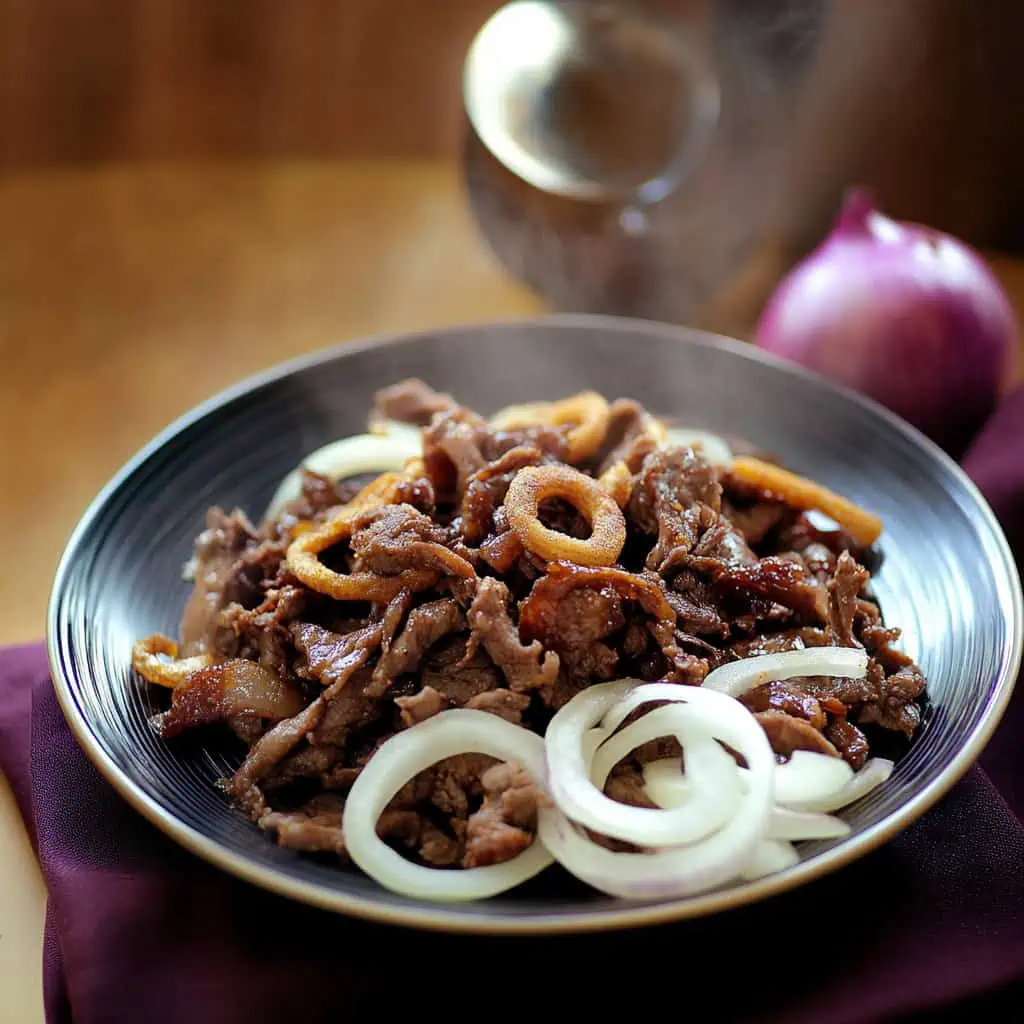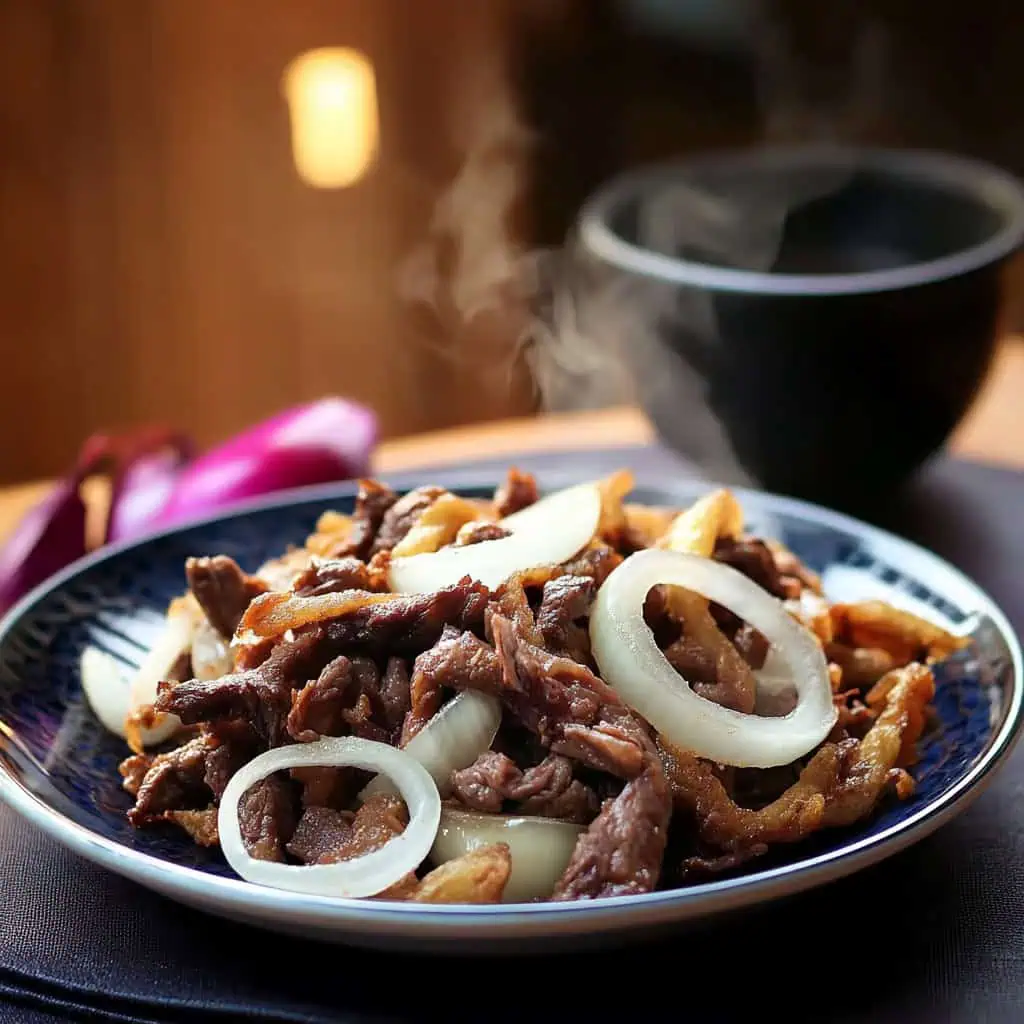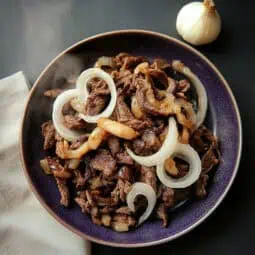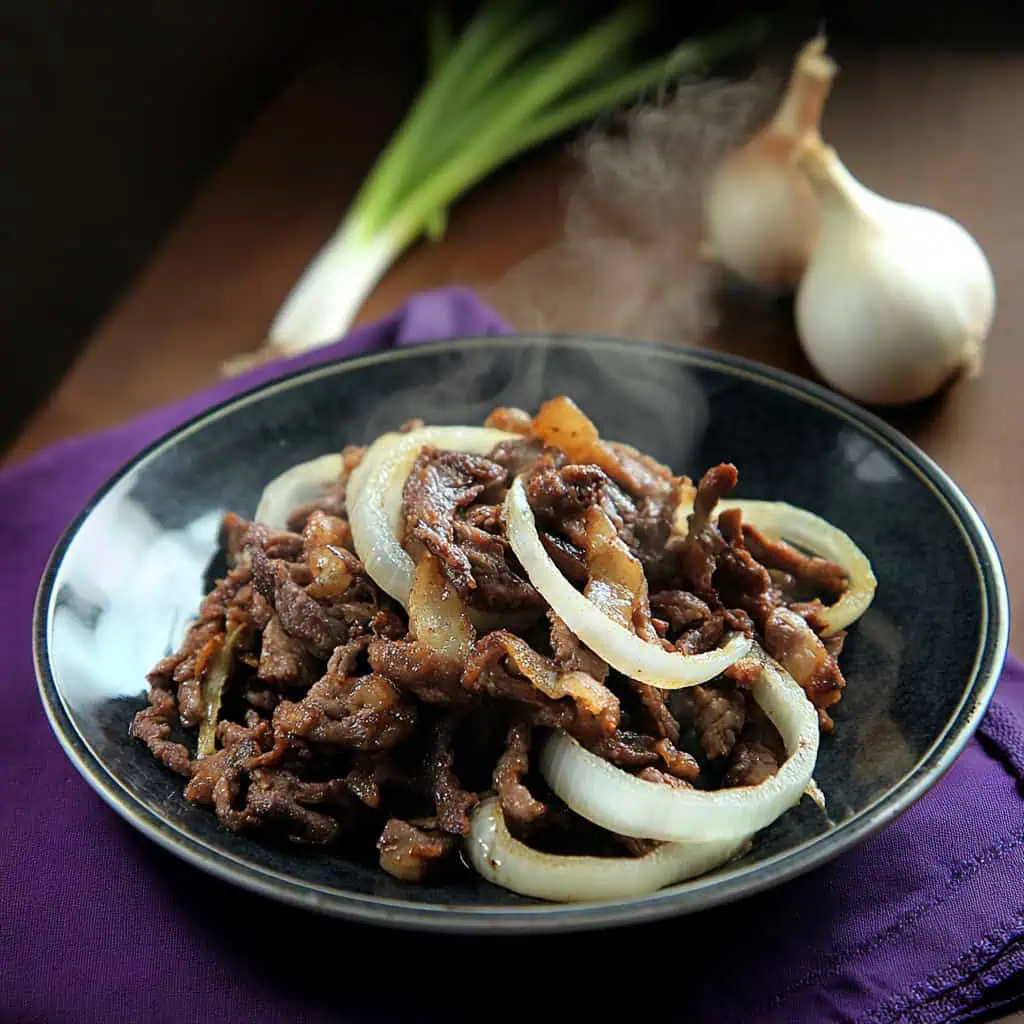Picture this: I found myself swept up in the electric energy of Dagupan's Pigar Pigar Festival last summer. The streets were buzzing with vendors, each with their sizzling woks sending up clouds of fragrant steam.
Following my nose and the happy chatter of locals, I watched in awe as seasoned cooks transformed whisper-thin slices of beef and liver into perfectly crispy bites. The sound of meat hitting hot oil was like music, and the ritual of tossing fresh onions with the still-sizzling meat had me mesmerized.
One bite of this street food legend, and I understood why they dedicated an entire festival to it. That first taste – crispy edges giving way to tender meat, the sharp bite of fresh onions – it was a revelation.
I'm bringing that street food magic to your kitchen with this tried-and-true recipe that captures the authentic flavors of Dagupan's beloved Pigar Pigar.
What is Pigar Pigar?
Pigar Pigar (pi-GAR pi-GAR) is an iconic street food from Dagupan City, Philippines, celebrated annually during the Pigar Pigar Festival. Originally made with carabeef (carabao/water buffalo meat), this dish features paper-thin slices of beef and liver, flash-fried until crispy, then tossed with fresh onions. The name "pigar pigar" is believed to come from the sound of meat being sliced on the chopping board.
Jump to:

Why You'll Love This Recipe
- Authentic street food experience from Dagupan's famous night market
- Perfect beer match (pulutan) for casual gatherings
- Quick cooking time despite the marination period
- Budget-friendly yet protein-rich dish
- Customizable heat levels with various dipping sauces
Ingredients
The ingredients in Pigar Pigar create a perfect balance of flavors and textures. Beef provides a hearty base, while beef liver adds a rich depth and distinctive taste that's characteristic of authentic Dagupan Pigar Pigar.
Paper-thin slicing ensures quick cooking and the signature crispy-yet-tender texture. Fresh white onions bring a sharp, crisp contrast that cuts through the richness of the fried meats. The simple marinade of soy sauce, salt, and pepper enhances the natural flavors without overpowering them, allowing the quality of the meat to shine through.
This straightforward combination creates a dish that's greater than the sum of its parts, showcasing the Filipino talent for transforming humble ingredients into something extraordinary.

- 500g beef sirloin or round, sliced paper-thin
- 150g beef liver, sliced paper-thin
- 1 large white onion, sliced into rings
- 4 tablespoons soy sauce
- 1 teaspoon salt
- 1 teaspoon black pepper
- Cooking oil for deep-frying
Optional Dipping Sauces:
- Spiced vinegar
- Calamansi soy sauce
- Chili garlic sauce
Equipment
- Sharp knife – Essential for achieving those paper-thin meat slices that make Pigar Pigar authentic
- Large wok or deep pan – Provides adequate space and depth for proper deep-frying
- Metal spider strainer or slotted spoon – Helps remove the meat from hot oil safely and efficiently
- Metal sieve or wire rack – Creates a draining station for excess oil to maintain crispiness
- Meat slicer (optional but recommended) – Ensures consistent thin slices for even cooking
- Heavy-duty cutting board – Provides a stable surface for precise meat slicing
- Mixing bowls – Used for marinating the meat properly

How To Make
- Place your beef and liver in the freezer for 30 minutes - this makes them much easier to slice very thin.
- While waiting, cut your onions into rings and set them aside.
- Take out your semi-frozen meat and slice it as thin as you possibly can, like paper. If you find this challenging, your local butcher can do this for you.
- Put all your sliced meat in a bowl. Add the soy sauce, salt, and black pepper. Mix everything well so all the meat is coated. Cover and let it sit in the fridge for at least one hour.
- Set up your cooking station. Put a wire rack or strainer over a tray - this is where your cooked meat will drain. Fill your wok or deep pan with enough oil for deep frying, about 2 inches deep. Heat the oil until it's very hot (375°F/190°C). Test it by dropping a tiny piece of meat - it should sizzle right away.
- Now for the frying: Add small batches of meat to the hot oil. Don't put too much at once or it won't cook properly. Fry until the edges get crispy and start to curl up, about 2-3 minutes. Using a strainer or slotted spoon, take out the meat and put it on your draining rack.
- Here's the final touch: While the meat is still really hot, quickly mix it with your fresh onion rings. The heat from the meat will slightly warm the onions but keep their crunch.
- Serve right away while everything's hot and crispy. If you're making a dipping sauce, mix some vinegar, soy sauce, and chopped chilies in a small bowl.
Important notes:
- Cook your beef and liver separately since liver cooks faster than beef.
- If cooking for a crowd, you can fry the meat ahead of time and just give it a quick refry right before serving to make it crispy again.

Tips from Lola's Kitchen
- Freezing technique: Partially freeze meat for exactly 30 minutes – not too hard, not too soft – for the perfect slicing texture
- Butcher help: Don't hesitate to ask your butcher to slice the meat – they have the right tools and experience
- Batch cooking: Keep meat and liver separate while frying as they have different cooking times (liver cooks about 30-40% faster)
- Frying space: Never overcrowd the pan – leave plenty of space between meat pieces to maintain oil temperature
- Prep work: Pat meat completely dry with paper towels before frying to prevent dangerous oil splatter
- Oil temperature: Invest in a cooking thermometer to maintain the perfect 375°F frying temperature
- Onion timing: Toss the onions with the meat immediately after draining for perfect onion texture
Substitutions
- Meat options: Replace beef with authentic carabeef (water buffalo) for the traditional version or use thinly sliced pork loin
- Liver alternatives: Substitute beef liver with chicken liver for a milder flavor or omit completely if preferred
- Onion variations: Use shallots or red onions instead of white onions for a different flavor profile
- Healthier version: Use avocado oil instead of regular vegetable oil for higher smoke point and health benefits
- Lower sodium: Reduce soy sauce to 2 tablespoons and use low-sodium soy sauce
- Gluten-free option: Replace soy sauce with tamari or coconut aminos
Troubleshooting
- Problem: Meat not getting crispy Solution: Ensure oil is hot enough (375°F) and meat is sliced very thin (1-2mm). Also, don't overcrowd the pan.
- Problem: Meat too tough Solution: Slices might be too thick. For tender results, ensure meat is sliced paper-thin and don't overcook – 2-3 minutes is usually sufficient.
- Problem: Onions too raw and pungent Solution: Toss onions with meat while it's still very hot from frying. The residual heat will slightly soften the onions without cooking them completely.
- Problem: Oil splattering excessively Solution: Meat wasn't dried properly before frying. Pat meat completely dry with paper towels and ensure there's no excess marinade.
- Problem: Meat sticking together while frying Solution: Add meat pieces one by one, giving each piece a few seconds before adding the next. Stir gently while frying.
Storage & Reheating
- Immediate consumption: Pigar Pigar is best enjoyed immediately after cooking for optimal crispiness and texture
- Refrigeration: Store leftovers in an airtight container in the refrigerator for up to 2 days
- Reheating method: To restore crispiness, briefly reheat in hot oil for 30-45 seconds – avoid microwaving as it will make the meat tough
- Marinade storage: Uncooked marinated meat can be stored in the refrigerator for up to 24 hours
- Freezing: Not recommended for cooked Pigar Pigar as it will lose its signature texture
- Meal prep tip: You can pre-slice and marinate the meat up to a day ahead, but always fry just before serving

FAQ
Why is my meat not getting crispy?
Ensure your oil is hot enough (375°F/190°C) and that the meat is sliced very thin (1-2mm). Also, make sure you're not overcrowding the pan, which lowers the oil temperature.
Can I make this without liver?
Absolutely! You can use all beef or substitute with other proteins like thinly sliced pork or chicken.
How thin should I slice the meat?
Aim for 1-2mm thickness, almost paper-thin. Semi-freezing the meat before slicing helps achieve this consistency.
Is this dish spicy?
The traditional version is not spicy, but you can add heat as preferred through dipping sauces or by adding chili flakes to the marinade.
Can I use an air fryer instead of deep-frying?
Yes, though the texture will be slightly different. Place meat in a single layer and cook at 400°F for 5-7 minutes, flipping halfway through.
What's the best cut of beef to use?
Sirloin or round cuts work best as they have good flavor while remaining tender when sliced thin. Avoid cuts with too much connective tissue.
Can I prepare this in advance for a party?
You can slice and marinate the meat in advance, but the frying should be done just before serving. If needed, you can fry ahead and quickly refry for 30 seconds before serving.
What's the origin of the name "Pigar Pigar"?
The name is believed to come from the sound of meat being sliced on the chopping board – "pig-ar, pig-ar" – mimicking the rhythmic chopping sound.
Related
Looking for other recipes like this? Try these:

Authentic Dagupan Pigar Pigar Recipe (Crispy Beef & Liver Street Food)
Equipment
- Sharp knife (for achieving paper-thin meat slices)
- Large wok or deep pan (for proper deep-frying)
- Metal spider strainer or slotted spoon (for removing meat from hot oil)
- Metal sieve or wire rack (for draining excess oil)
- Meat slicer (optional but recommended for consistent thin slices)
- Heavy-duty cutting board
- Mixing bowls (for marination)
Ingredients
For the Meat:
- 500 g beef sirloin or round karne ng baka, sliced paper-thin
- 150 g beef liver atay ng baka, sliced paper-thin
- 1 large white onion sibuyas, sliced into rings
- 4 tablespoon soy sauce toyo
- 1 teaspoon salt asin
- 1 teaspoon black pepper paminta
- Cooking oil for deep-frying
Optional Dipping Sauces:
- Spiced vinegar suka
- Calamansi soy sauce
- Chili garlic sauce
Instructions
- Begin by putting your beef and liver in the freezer for 30 minutes - this makes them much easier to slice super thin.
- While waiting, cut your onions into rings and set them aside.
- Take out your semi-frozen meat and slice it as thin as you possibly can, like paper. If you find this tricky, your local butcher can do this for you.
- Put all your sliced meat in a bowl. Add the soy sauce, salt, and black pepper. Mix everything well so all the meat is coated. Cover and let it sit in the fridge for at least one hour.
- Set up your cooking station. Put a wire rack or strainer over a tray - this is where your cooked meat will drain. Fill your wok or deep pan with enough oil for deep frying, about 2 inches deep. Heat the oil until it's very hot (375°F/190°C). Test it by dropping a tiny piece of meat - it should sizzle right away.
- Now for the frying: Add small batches of meat to the hot oil. Don't put too much at once or it won't cook properly. Fry until the edges get crispy and start to curl up, about 2-3 minutes. Using a strainer or slotted spoon, take out the meat and put it on your draining rack.
- Here's the final touch: While the meat is still really hot, quickly mix it with your fresh onion rings. The heat from the meat will slightly warm the onions but keep their crunch.
- Serve right away while everything's hot and crispy. If you're making the traditional dipping sauce, just mix some vinegar, soy sauce, and chopped chilies in a small bowl.
- Remember to cook your beef and liver separately since liver cooks faster than beef. And if you're cooking for a crowd, you can fry the meat ahead of time and just give it a quick refry right before serving to make it crispy again.
Tips from Lola's Kitchen
- Partially freeze meat for 30 minutes before slicing for easier handling
- Ask your butcher to slice the meat if available
- Keep meat and liver separate while frying as they have different cooking times
- Don't overcrowd the pan to maintain oil temperature
- Pat meat dry before frying to prevent oil splatter
Nutrition
The Story Behind Dagupan's Famous Pigar Pigar
In the heart of Pangasinan province lies Dagupan City, where the story of Pigar Pigar unfolds along its bustling streets. This beloved street food, whose name is said to mimic the rhythmic sound of knife blades hitting wooden chopping boards (pig-ar, pig-ar), emerged from the city's vibrant night market culture decades ago.
Originally, Pigar Pigar was crafted using carabeef - meat from the carabao or water buffalo, an animal deeply woven into Philippine agricultural life. Street vendors would slice the tough but flavorful meat paper-thin, a technique that transformed the humble ingredient into a crispy delicacy. As beef became more readily available, it gradually replaced carabeef in most versions, though purists still seek out the original water buffalo meat for its distinctive taste.
The dish's popularity exploded in the streets surrounding CSI City Mall, where each evening, as office workers headed home and shops began to close, an extraordinary transformation would take place. Like a well-choreographed dance, vendors would appear with their portable stalls, woks, and chopping boards, turning the ordinary street into a aromatic food haven reminiscent of Bangkok's famous night markets.
What sets Dagupan's Pigar Pigar apart is its beautiful simplicity. While other street foods rely on complex spice blends or special sauces, Pigar Pigar lets its core ingredients shine - perfectly fried meat with edges crisped just so, complemented by the sharp bite of fresh onions. This winning combination has earned such a following that Dagupan now celebrates an annual Pigar Pigar Festival, where vendors compete for the title of best version while sharing their cherished techniques.
Today, Pigar Pigar transcends its humble street food origins. You'll find it served in traditional carinderia eateries, upscale Filipino restaurants, and even in modern gastropubs where it's paired with craft beer. The dish represents the Filipino talent for transforming simple ingredients into something extraordinary, a tradition passed down through generations of street food vendors who have made Dagupan's food scene legendary.
As food tourism grows in the Philippines, Pigar Pigar has become more than just a local favorite - it's now a must-try dish for visitors exploring Filipino cuisine. Many travel to Dagupan specifically to taste authentic Pigar Pigar, making it a significant part of the city's culinary tourism. Whether enjoyed from a street vendor's stall or recreated in home kitchens worldwide, each crispy, onion-laden bite tells the story of Dagupan's rich street food heritage.










Comments
No Comments